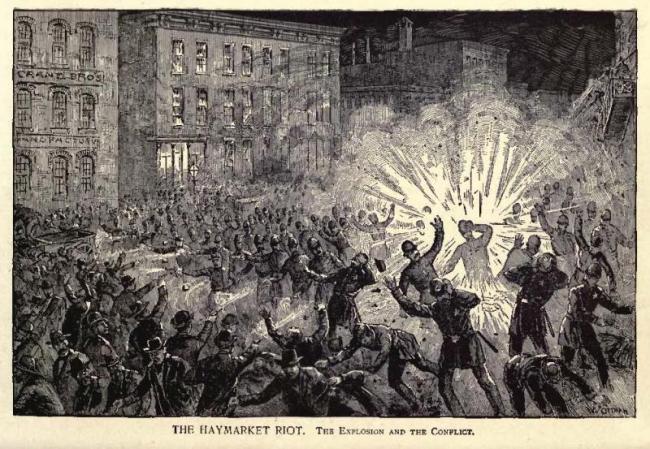Going Out With A Bang

The Haymarket Square Riot of 1886
On May 4, 1886, a rally in Chicago literally exploded.
The rally was sparked by an outbreak of violence during a strike at the McCormick Reaper Works factory the day prior. Strikers, protesting strenuous work hours, were attacking “scabs” (workers who returned to work instead of striking) exiting the building. About 200 police came onto the scene, waving nightsticks and firing guns, tragically killing two workers.
To retaliate against police, approximately 1,500 workers, anarchists and labor radicals gathered the next day in Haymarket Square. Chicago Mayor, Carter Harrison, stationed police a block from the Square, in case of emergency.
Although the rally wavered on without violence, the Mayor sent police onto the scene in hopes of sending the diminishing crowd home. But, as police approached, an explosive hurled from the crowd combusted in the path of the police.
Chaos ignited and police open fired, killing at least seven policemen and one civilian. Close to 100 attendees were injured according to History.com, but the exact number is unknown, as most protesters did not want to confess that they had even attended.
But the Haymarket Riot not only resulted in lives tragically lost. Soon after, a wave of xenophobia swept over Chicago, since many of those associated with the anarchist and labor radical groups were immigrants from Germany.

Although the bomber was never identified, seven men associated with extremist groups, were tried (some say unfairly) for “accessory for murder” based upon their “inflammatory speeches.”
An eighth man, Albert Parsons, leader of the anarchist group, American Branch of the International Working People’s Association (I.W.P.A.) reportedly turned himself in in order to go down with his people.
All eight men were convicted.
Seven men were sentenced to death and one to 15 years in prison. The night before execution, perhaps as a testament to the deed, one of the sentenced prisoners blew himself up in his cell with a dynamite cigar.
It’s been 130 years since the Haymarket Riot, but union strikes are still in our headlines.
The first piece in the The Center for Worker Freedoms’ series, Blood and Boots: A History of Union Violence, reflects on the shocking number of reported union-related violence since 1975. This evidence counters the notion of “progress” proclaimed by many labor unions.
Unless moving from explosive devices to drones for intimidation tactics is your version of “progress.”





